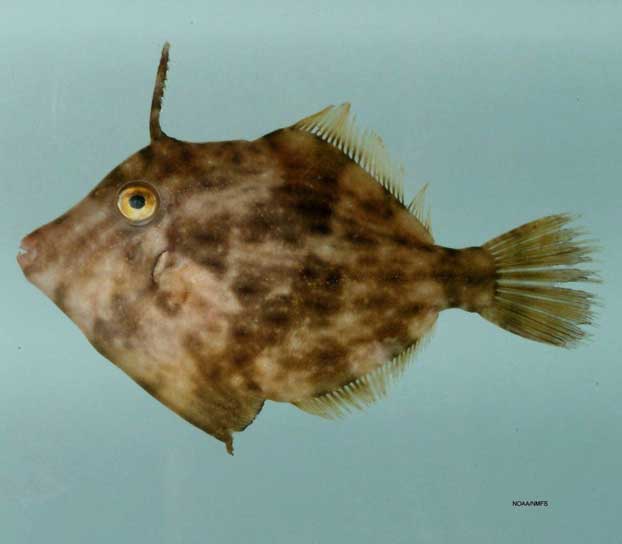
Stephanolepis hispida (SEFSC Pascagoula Laboratory; Collection of Brandi Noble, NOAA/NMFS/SEFSC )
Superregnum : Eukaryota
Cladus: Unikonta
Cladus: Opisthokonta
Cladus: Holozoa
Regnum: Animalia
Subregnum: Eumetazoa
Cladus: Bilateria
Cladus: Nephrozoa
Superphylum: Deuterostomia
Phylum: Chordata
Subphylum: Vertebrata
Infraphylum: Gnathostomata
Megaclassis: Osteichthyes
Superclassis/Classis: Actinopterygii
Classis/Subclassis: Actinopteri
Subclassis/Infraclassis: Neopterygii
Infraclassis: Teleostei
Megacohors: Osteoglossocephalai
Supercohors: Clupeocephala
Cohors: Euteleosteomorpha
Subcohors: Neoteleostei
Infracohors: Eurypterygia
Sectio: Ctenosquamata
Subsectio: Acanthomorphata
Divisio/Superordo: Acanthopterygii
Subdivisio: Percomorphaceae
Series: Eupercaria
Ordo: Tetraodontiformes
Familia: Monacanthidae
Genera: Stephanolepis
Species: Stephanolepis hispida
Stephanolepis hispidus, the planehead filefish, is a species of bony fish, a ray-finned fish in the family Monacanthidae.
Description
The planehead filefish grows to a maximum length of 27 centimetres (11 in) but is more typically about 17 centimetres (6.7 in) long. The colour is cryptic, being a more or less mottled pale brown, olive or green on a light coloured background, sometimes with darker brown splotches and streaks. The fish is laterally compressed and deep bodied. The snout is elongated with a terminal mouth. The large yellow eye is set high on the head and above it is a prominent retractable spine. This is the anterior of the two spines associated with the long dorsal fin, which also has 29 to 35 soft rays. The anal fin has no spines and between 30 and 35 soft rays. The pectoral fins are small and the tail fin is large and fan-shaped, often with two darker coloured bands.[3][4][5]
Planehead filefish are sexually dimorphic. In mature males, the second soft ray of the dorsal fin becomes greatly elongated and the scales on either side of the caudal peduncle develop into a patch of bristles. The elongated ray reaches between 104 and 128 mm. Females do not develop secondary sexual characteristics. They tend to have greater body depth than males, but variation in this trait exists in both sexes and overlap in measurements are recorded.[5]
Distribution and habitat
The planehead filefish is found in the Atlantic Ocean at depths of up to 300 metres (980 ft). Its range extends from Nova Scotia to Uruguay in the west and from the Canary Islands to Angola in the east. It is found near the seabed on reefs and over sandy and muddy sea floors. It is often found among Sargassum seaweed.[3]
Biology
In the Canary Islands the growth and ageing of the planehead filefish have been studied. Spawning takes place in the summer and the age of the fish is established by using the fast and slow growth rings found in the anterior dorsal fin spine. The species has a lifespan of about three years and reaches half its final length by the end of its first year.[6]
Uses
The planehead filefish can be used for human consumption. In the Canary Islands it is caught in fish traps and at one time was considered to be a by-catch, incidental to the capture of other, more desirable fish. However, since the 1980s, it has become a target species in its own right and by 2000, there were concerns about overfishing.[6]
Synonyms[2]
Balistes hispidus Linnaeus, 1766
Monacanthus auriga Lowe, 1852
Monacanthus filamentosus Valenciennes, 1838
Monacanthus gallinula Valenciennes, 1843
Monacanthus hispidus (Linnaeus, 1766)
Monacanthus oppositus Poey, 1860
Monacanthus setifer DeKay, 1842
Monacanthus spilonotus Cope, 1871
Monocanthus setifer DeKay, 1842
Stephanolepis hispida (Linnaeus, 1766)
References
Matsuura, K., Tyler, J. & Robertson, R. 2015. Stephanolepis hispidus (errata version published in 2017). The IUCN Red List of Threatened Species 2015: e.T16781168A115366674. https://dx.doi.org/10.2305/IUCN.UK.2015-4.RLTS.T16781168A16782263.en. Downloaded on 20 July 2020.
Bailly, Nicolas (2010). "Stephanolepis hispidus (Linnaeus, 1766)". WoRMS. World Register of Marine Species. Retrieved 2012-01-04.
Stephanolepis hispidus (Linnaeus, 1766) FishBase. Retrieved 2012-01-04.
Stephanolepis hispidus, Marine Species Identification Portal. Retrieved 2012-01-04.
Frederick H. Berry and Louis E. Vogele (1959). "Filefishes (Monacanthidae) of the western North Atlantic" (PDF). Fishery Bulletin. 61: 61–109.
Berry, Frederick H.; Voegle, Louis E. (2004). "Age and growth of Stephanolepis hispidus (Linnaeus, 1766) (Pisces: Monacanthidae), in the Canary Islands area". Fisheries Research. 66 (2–3): 381–386. doi:10.1016/j.fishres.2003.07.002.
Retrieved from "http://en.wikipedia.org/"
All text is available under the terms of the GNU Free Documentation License

